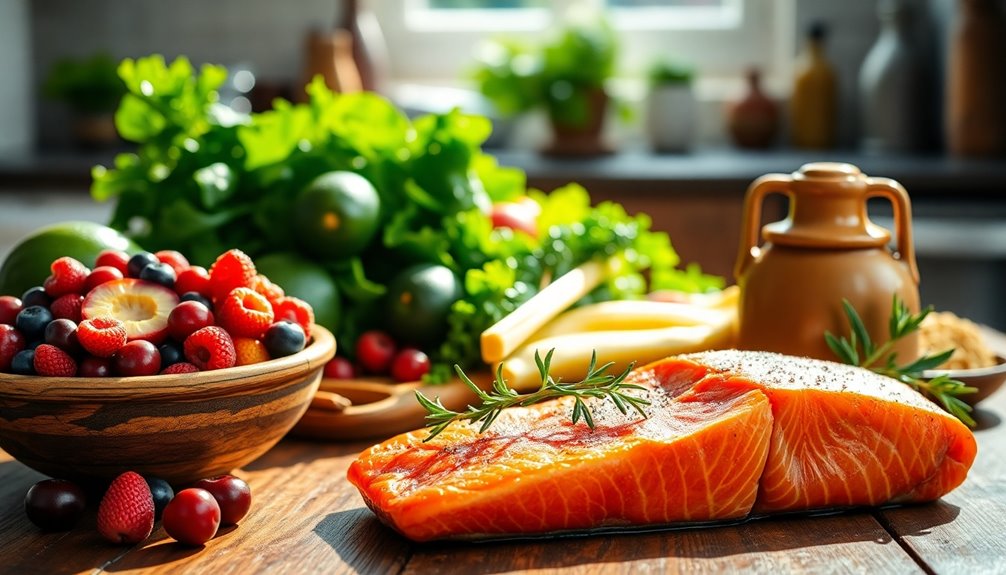The Paleo diet focuses on whole, unprocessed foods that mirror what our hunter-gatherer ancestors ate. By prioritizing lean meats, vegetables, fruits, and healthy fats, you can nourish your body with essential vitamins and minerals. This diet aims to improve weight loss, gut health, and energy levels while minimizing processed foods, grains, and legumes. While it offers numerous benefits, be aware of potential drawbacks like nutrient deficiencies and social challenges. Meal planning and batch cooking can enhance your success. Curious about how to implement the Paleo diet effectively? There's a wealth of strategies and tips waiting for you.
Key Takeaways
- The Paleo diet emphasizes whole, unprocessed foods similar to those consumed by our hunter-gatherer ancestors for optimal health.
- Key foods include lean meats, vegetables, fruits, and healthy fats, while avoiding processed foods, grains, and legumes.
- Health benefits include weight loss, improved gut health, increased energy levels, reduced inflammation, and better metabolic health.
- Meal planning and batch cooking are essential for success, along with checking labels to avoid hidden sugars.
- Potential drawbacks include nutrient deficiencies, social challenges while dining out, and risks associated with high blood pressure or cardiovascular issues.
What Is the Paleo Diet?
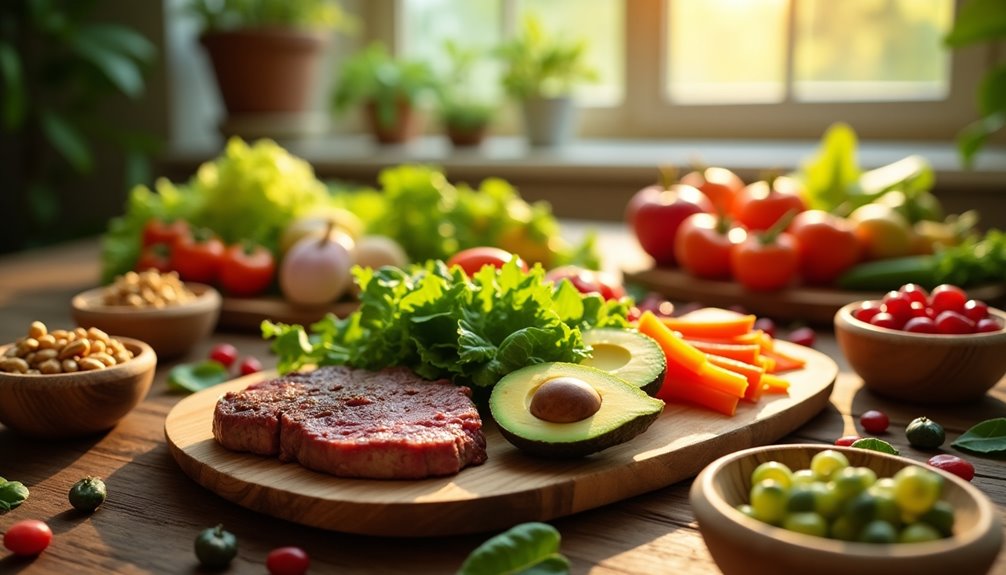
The Paleo diet, often referred to as the "caveman diet," emphasizes whole, unprocessed foods that our ancestors might've consumed. This dietary approach is rooted in an evolutionary perspective, suggesting that our bodies are best suited for the foods available to hunter-gatherers. By focusing on nutrient-rich foods, you aim to nourish your body with the vitamins and minerals it craves, promoting prime health.
When you adopt the Paleo diet, you typically choose meats, fish, fruits, vegetables, nuts, and seeds while avoiding processed foods, grains, and dairy. This shift not only encourages you to eat more wholesome ingredients but also connects you to a primal way of eating that many find satisfying and fulfilling. You may discover a sense of belonging within a community that shares similar values, appreciating the simplicity and authenticity of real foods. Additionally, many individuals transitioning to the Paleo diet report experiencing improved energy levels and a reduction in cravings, similar to those benefits found in the Keto diet.
Research suggests that this evolutionary approach can lead to various health benefits, including weight loss, improved metabolic health, and reduced inflammation. By prioritizing nutrient-rich foods, you're likely to feel more energetic and mentally sharp, enjoying meals that fuel your body rather than hinder it.
Engaging with the Paleo diet can also foster a deeper connection to your food sources, encouraging you to ponder where your meals come from. As you explore this lifestyle, you might find it not only enhances your well-being but also creates a community of like-minded individuals who support each other in their health journeys.
Key Principles of Paleo
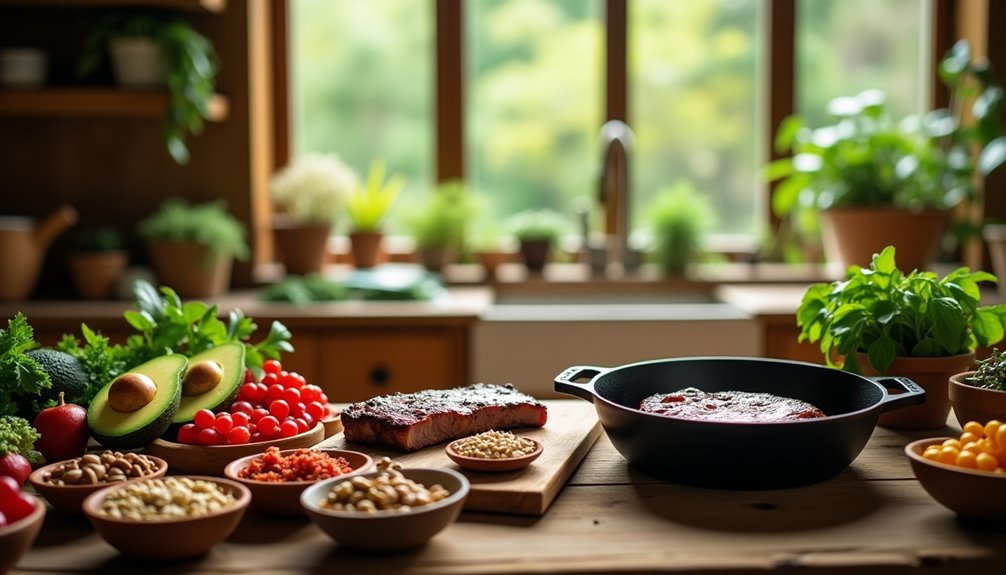
Frequently, those who adopt the Paleo diet find that its core principles revolve around choosing whole, nutrient-rich foods while eliminating processed items. The goal is to mirror the eating patterns of our ancestors, which is ingrained in an evolutionary perspective. By focusing on foods that our bodies naturally evolved to consume, you can enhance your overall health and well-being.
One of the main beliefs of the Paleo diet is prioritizing nutrient richness. This means selecting foods that offer the highest amount of vitamins, minerals, and other beneficial compounds per calorie. By doing so, you not only fuel your body with essential nutrients but also support vital health. Picture filling your plate with colorful vegetables, high-quality meats, and healthy fats—all packed with nutrients that promote liveliness.
Another fundamental principle is minimizing or completely avoiding processed foods, which often contain added sugars, unhealthy fats, and artificial ingredients. These substances can lead to inflammation and other health issues. By steering clear of these items, you can help your body maintain a balanced state, allowing you to feel your best. Moreover, adopting a diet rich in antioxidants and fiber as seen in plant-based diets can further enhance your overall health.
Ultimately, embracing the Paleo diet's core principles isn't just about food choices; it's about adopting a lifestyle that honors your body's needs. As you connect with this way of eating, you may discover a sense of belonging within a community that values health, sustainability, and mindful eating. This journey can be both rewarding and transformative, fostering a deeper appreciation for the foods you consume.
Foods to Include

When you embrace the Paleo diet, filling your meals with nutrient-rich foods becomes crucial. This approach emphasizes whole, unprocessed foods that your ancestors would've consumed, making it a straightforward way to nourish your body. Start by incorporating a variety of lean meats, such as grass-fed beef, free-range chicken, and wild-caught fish. These proteins are essential for muscle repair and overall health.
Next, fill your plate with plenty of vegetables. Leafy greens, broccoli, bell peppers, and zucchini offer important vitamins and minerals. Don't shy away from colorful produce; the variety ensures a wide range of nutrients. Fruits, especially berries, are great for satisfying your sweet tooth while providing antioxidants.
Healthy fats are another foundation of the Paleo diet. Avocados, nuts, seeds, and olive oil are excellent sources that support brain health and keep you satisfied. When planning your meals, consider batch cooking to simplify your week. Meal prep can save time and help you stick to your dietary goals, guaranteeing you always have nourishing options on hand.
For creative meal ideas, try zoodles (zucchini noodles) with a homemade pesto or a hearty salad topped with grilled chicken and sliced avocado. These recipe ideas not only promote a sense of community as you share them with friends but also make following the Paleo diet enjoyable. By focusing on these wholesome foods, you'll discover a gratifying way to nourish your body and mind. Additionally, incorporating more plant-based foods into your diet can further enhance your overall health and environmental impact.
Foods to Avoid

While focusing on nutrient-rich foods can enhance your health on the Paleo diet, it's equally important to recognize what to leave off your plate. To truly embrace the Paleo lifestyle, steering clear of specific food groups can make a significant difference in your overall success.
First and foremost, processed foods should be avoided. These items often contain artificial ingredients, preservatives, and added sugars that can derail your health goals. Instead, opt for whole foods that are as close to their natural state as possible. This shift not only helps you feel better but also fosters a deeper connection with what you consume.
Next, grains are another category to exclude. Whether it's wheat, barley, or rice, grains can introduce gluten and other anti-nutrients that may disrupt digestion and nutrient absorption. By cutting grains from your diet, you may find that your body responds more positively to the foods you do eat. In fact, eliminating high glycemic index grains can even help stabilize your blood sugar and reduce cravings.
Legumes, including beans and lentils, are also off the menu. Though they're often considered healthy, legumes can contain compounds that interfere with nutrient absorption. Many people on the Paleo diet report feeling lighter and more energetic after eliminating these foods.
Health Benefits of Paleo
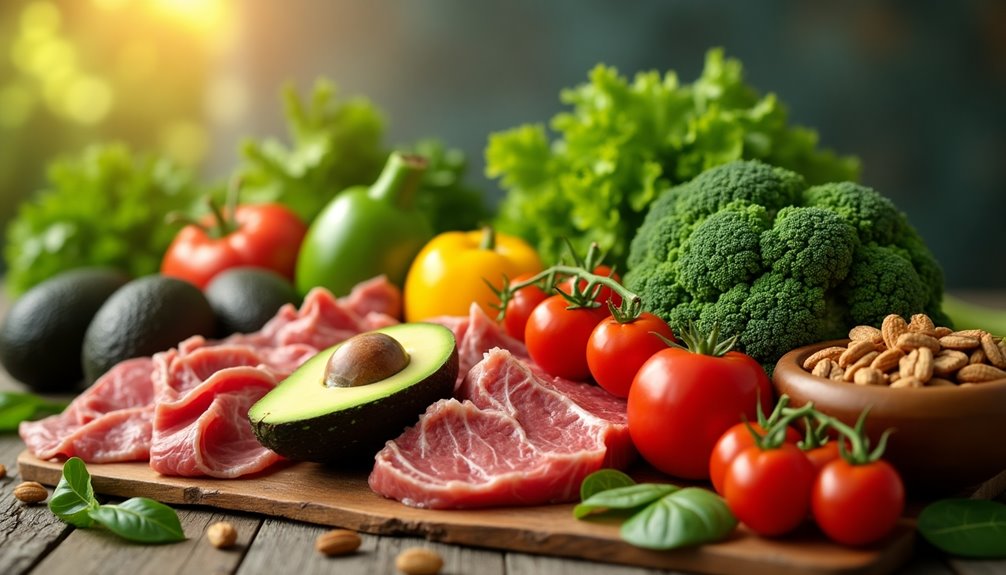
Embracing the Paleo diet can lead to a range of health benefits that support both physical and mental well-being. One of the most notable advantages you might experience is weight loss. By focusing on whole, unprocessed foods, you can reduce calorie intake while still feeling satisfied. This approach encourages you to consume lean meats, fruits, vegetables, and healthy fats, which can help you shed excess pounds and maintain a healthy weight over time.
Additionally, the long-term effects of adopting the Paleo diet can remarkably improve your gut health. Many people report better digestion and reduced bloating when they eliminate grains, legumes, and processed foods. By prioritizing nutrient-dense options, you're likely to support a balanced gut microbiome, which is essential for overall health.
You may also notice a boost in your energy levels. Unlike processed carbohydrates that often lead to energy crashes, the Paleo diet's emphasis on whole foods can provide a steady energy supply throughout the day. This sustained energy can enhance your productivity and mood, making it easier to engage in physical activities and social connections.
Incorporating the Paleo diet into your lifestyle not only fosters physical health but also nurtures a sense of community. Sharing meals and recipes with like-minded individuals can create a supportive network, reinforcing the positive changes you're making. Moreover, adopting a custom keto diet plan can further enhance your journey by providing tailored meal options that align with your dietary preferences. By focusing on these benefits, you'll likely find yourself feeling better both inside and out.
Potential Drawbacks
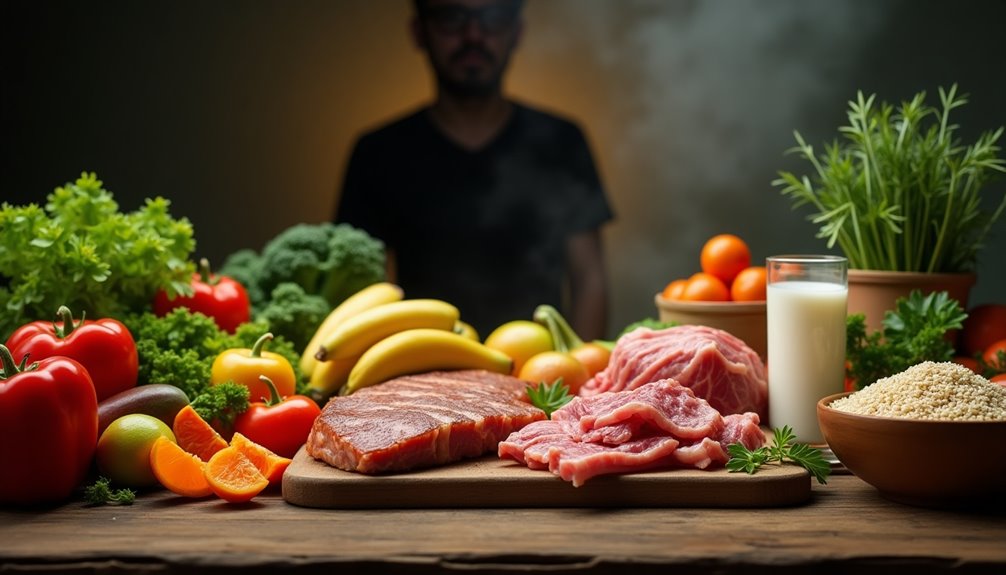
Many people find the Paleo diet appealing, but it's important to weigh some potential drawbacks before fully committing. One significant concern is the risk of nutrient deficiencies. By eliminating entire food groups like grains, legumes, and dairy, you might miss out on essential vitamins and minerals. For instance, whole grains are a great source of fiber and B vitamins, while dairy products provide calcium and vitamin D. Without careful planning, your body could suffer from these deficiencies, leading to health issues over time.
Another drawback involves social challenges. Following the Paleo diet can make social situations, like dining out or attending gatherings, tricky. Many restaurants offer limited options that align with Paleo principles, which could make eating out a frustrating experience.
Additionally, friends and family may not share your dietary preferences, potentially leading to awkwardness during meals or celebrations. You might find yourself explaining your choices repeatedly, which can feel isolating. Furthermore, neglecting certain food groups can lead to nutrient deficiencies, which may increase the risk of developing high blood pressure or cardiovascular issues.
It's essential to recognize these challenges as you consider the Paleo diet. While it offers numerous health benefits, be mindful of how these potential drawbacks could affect your lifestyle and relationships. Balancing your dietary choices with social interactions is key to ensuring you maintain a sense of belonging while pursuing your health goals. Ultimately, being informed about both the positives and negatives can help you make a decision that aligns with your personal values and lifestyle.
Paleo Diet for Beginners

Starting the Paleo diet can feel overwhelming, especially with the potential challenges you've just considered. However, by breaking it down into manageable steps, you can navigate this journey more smoothly.
First, focus on meal planning. Preparing your meals in advance not only saves time but also helps you stay committed to the diet. Aim to create a weekly menu that includes a variety of meats, vegetables, fruits, nuts, and seeds. This way, you'll enjoy diverse flavors while ensuring you get all the nutrients your body needs.
Next, tackle grocery shopping. Make a list based on your meal plan to avoid impulse buys. Stick to the perimeter of the store where fresh foods are typically located, as this aligns with the Paleo philosophy of eating whole, unprocessed foods. Look for organic and grass-fed options when possible, as these choices often offer higher nutrient content.
Don't forget to check labels—many packaged foods contain hidden sugars and preservatives that don't fit into the Paleo lifestyle. As you shop, remember you're part of a growing community that values health and nutrition. Connecting with others who share this journey can provide support and encouragement. Additionally, understanding the importance of natural calorie cycles can further enhance your health journey while following the Paleo diet.
Ultimately, embracing the Paleo diet is about finding what works best for you. With thoughtful meal planning and strategic grocery shopping, you'll set yourself up for success while enjoying the process of nourishing your body with wholesome foods.
Tips for Success
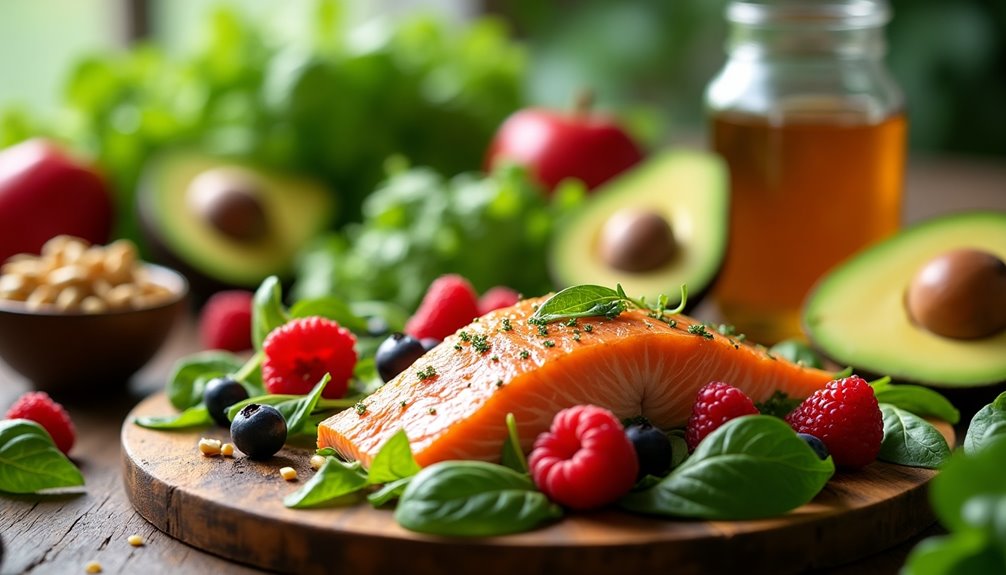
To thrive on the Paleo diet, consistency and adaptability are key. Start by embracing meal planning. Take time each week to outline your meals, focusing on whole foods like lean meats, fish, fruits, vegetables, nuts, and seeds. This not only helps you stay on track but also makes grocery shopping more efficient. Consider batch cooking to have meals ready when you're busy or tempted to stray from your plan.
When it comes to social situations, having a strategy is essential. You don't have to skip gatherings or feel left out. Before attending an event, communicate with the host about the menu. If you're unsure, offer to bring a Paleo-friendly dish. This way, you'll have something to enjoy, and you might inspire others to explore healthier options.
It's also helpful to keep in mind that occasional indulgences won't derail your progress. If you find yourself facing non-Paleo options, choose wisely and savor the experience without guilt. Balance is fundamental—it's about making healthier choices most of the time while allowing for life's pleasures.
Lastly, connect with others who share your journey. Join online forums or local groups where people discuss their experiences and tips. Having a support network can enhance your commitment and motivate you to stick with the Paleo lifestyle. Remember, it's not just a diet; it's a way to nourish your body and connect with a community that values health and wellness. Additionally, many find that following a structured program can enhance metabolism and weight loss while providing valuable resources and support.
Frequently Asked Questions
Can I Still Enjoy Desserts on the Paleo Diet?
Absolutely, you can enjoy desserts while sticking to your principles! Just look for paleo-friendly treats that use natural ingredients. You'll find plenty of recipes that incorporate sugar alternatives like honey, maple syrup, or coconut sugar. These options let you satisfy your sweet tooth without sacrificing your dietary preferences.
Embracing these alternatives makes it easy to indulge while still feeling connected to a community that values health and wellness. Enjoy your treats guilt-free!
How Does the Paleo Diet Impact Athletic Performance?
So, you think you can just munch on caveman snacks and expect to run marathons? Well, while it might sound like a prehistoric fantasy, the truth is, a well-organized diet can boost your muscle recovery and endurance. You'll notice improved energy levels and stamina, but it's pivotal to balance those nutrients.
Is the Paleo Diet Suitable for Children?
When considering if a diet is appropriate for children, you need to focus on their nutritional needs and growth development. Kids require a balanced intake of nutrients for proper development, including proteins, carbohydrates, and fats. While some aspects of this diet can be beneficial, it's crucial to make sure it meets all these needs.
Consulting a pediatrician or nutritionist can help you tailor a healthy plan that supports your child's growth and overall well-being.
Can I Drink Alcohol While Following the Paleo Diet?
You might wonder if you can drink alcohol while following a specific eating plan. Alcohol consumption can be tricky; some people choose to indulge on cheat days, while others prefer to avoid it altogether.
If you decide to drink, opt for options with fewer sugars, like dry wines or spirits mixed with soda water. Remember, moderation is key, as excessive drinking can undermine your health goals and make it hard to stay on track.
How Do I Handle Dining Out on the Paleo Diet?
When dining out, remember, "Where there's a will, there's a way." You've got plenty of restaurant options that cater to your needs.
At social gatherings, don't hesitate to ask about ingredients or request modifications. Focus on grilled meats, vegetables, and salads. Many places offer paleo-friendly choices, so you can enjoy yourself without feeling left out.
Planning ahead and being open can help you navigate these situations while staying true to your dietary preferences.
Conclusion
So, if you're ready to channel your inner caveman and swap your granola bars for bison steaks, the Paleo diet might just be your ticket to prehistoric health. Sure, you might miss out on pizza and ice cream, but think of the bragging rights at dinner parties! Just remember, it's not just about eating like a hunter-gatherer; it's about finding balance and nourishment in your modern life. After all, even cavemen didn't binge on mammoth meat every day!

